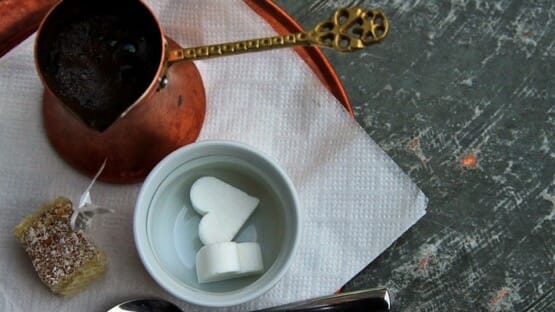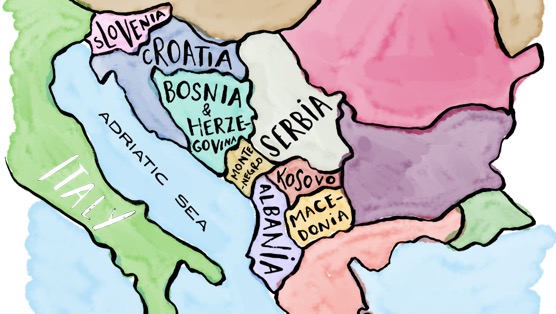A Balkan Love Letter: Old-School Travel
A Forum About Travel in Southeastern Europe
Travel Features Tourism
History lives beneath me.
On June 28, 1914, 101 years ago, the Austrian Archduke Franz Ferdinand and his wife Sophie were killed on the street corner below my apartment building in Sarajevo. The bullets that killed the Archduke and his wife lit the fuse for World War I. For many this also marked the beginning of the modern era. Directly next to the spot where the assassination took place sits the bakery I visit every morning. When I arrive in the early hours, my hair has a garage sale-wig quality—coarse and rebellious like inmates trying to escape a prison fire—the sort you find resting on a styrofoam head in which a five-year-old has carved off the nose and planted an off-center, senile-hooker mouth with a red crayon.
When I return to my apartment, I open the window blinds and observe the gaggles of tourists who gather around the corner. Croissant in one hand and coffee in the other, I watch as they ooh and ahh at appropriate intervals when the tour guide—like a character from a silent movie—points, arm outstretched, to where the shot originated and then points to where she’s standing to indicate the final result.
The assassination and this tour stop are, for better or worse, among the Bosnian capital’s calling cards.
People, myself included, are drawn to drama. I wonder, while scratching my belly and now staring blankly at the street, if the gaggles are as impressed by the fact that this city is also known as the European Jerusalem, because Muslim, Catholic, Orthodox Christian and Jewish traditions all reside in buildings within feet of each other. I wonder if they care that the mountains surrounding town were the sites of the 1984 Winter Olympic Games and not just the war in the 1990s. I wonder if they are aware that Sarajevo is one of the safest capitals on the continent.
For the record, aides begged the Archduke not to go to the Bosnian capital that day. He’d been warned of assassination-attempt rumors. Inside the little museum dedicated to the shooting, I’ve often stared at pictures of Ferdinand from that day and wondered what must have been going through his mind just over a century ago. As he passed the corner below my window in the open-air backseat of a car, Franz was wearing a tall, top hat-sized chapeau. A shock of green feathers sprouted atop it, like someone had placed a fern on his head as a drunken practical joke. For some reason the phrase Never go out in something you’ll be ashamed to walk home in the next morning always comes to mind.

History invites creativity.
My awe of the Balkans region is accentuated with every visit to nearly any locale. This peninsula in Southeastern Europe, where empires collided and religions split, is a vortex where helpings of world change are doled out by the shovel full not by the teaspoon. Here, where East meets West, my mission is simple—as both a travel writer and a person—absorb as much about the past as possible and offer it to my friends and readers in a way that doesn’t perpetuate hackneyed misconceptions but relays why visitors like myself should care about the now … today … and for the positive, life-changing vacations we are all planning tomorrow.
As I write—right now, this moment—the call to prayer echoes through the valley cradling Bosnia’s chief city, which was established by the Ottoman Empire in 1461 and industrialized by the Austro-Hungarian Empire starting in 1878. From my window overlooking the Miljaska River, which bisects town, I can see the minarets from six different mosques framed by the Dinaric Alps. The stone Latin Bridge below me, where the fern-adorned Archduke made his greatest contribution to history, leads to the neo-Gothic Franciscan Church and Monastery. A wedding-procession convoy of cars honking their horns and pumping traditional music, which some might call gypsy, passes beneath the green copper roof of the church’s garnet-colored bell tower and harmonizes with the minarets amplifying the wailing of muezzins.
History evolves.
When I first arrived to the Balkans—to, in fact, Sarajevo—I specifically remember thinking these words to myself: “This feels like the moon.”
It wasn’t because of the damage still evident from the nearly four-year siege, which had ended less than two years before. I didn’t move to Bosnia and Herzegovina specifically because of the war. And it wasn’t because I had any idea what it was like to be on the moon. My internal description was instinctive and without filter.
Simply stated, I had never been anywhere so foreign. And, I was still in Europe.

Artwork: Sarah Lawrence
Sure, I noticed the damage. And, there was no mistaking the almost palpable mixture of euphoria and dread in the years that immediately followed the conflict in Sarajevo. But as my taxi driver dropped me off in the Old Town that day and I stepped out onto the cobbled streets of the Ottoman-era quarter, known as Bascarsija, I was more consumed by the flow and rhythm of the people.
I could hear hammer-pinging from alleyways filled with artisans still working with copper, iron, gold, and silver like they had for centuries. The smell of a flaky meat pastry called burek, which is baked under a “bell” cover surrounded by scorching-hot coals, floated in the air and immediately made my stomach rumble. Behind me, a shop called Tip Top, which still operates, was dishing out syrupy portions of baklava. Men, athletic and loose, stood in groups on corners and laughed easily. The women, hidden behind sunglasses, were heartbreakingly beautiful and oblivious to stares.
At outdoor cafes, collections of these physically smooth and confident creatures poured coffee from little copper pots (made in the same artisan shops) into shot glass-sized cups and talked with great animation about what could only have been the solutions to all of the region’s issues. They paused to light up and then restated their talking points, punctuated with the red cherries of cigarettes thrust through clouds of smoke.
For what it’s worth, when I walk though Old Town today I still feel the same way. And, in full disclosure, I am biased. It’s almost impossible for me not to be. My grandparents were Slavic, Balkan even, but that’s not the reason. Closer to the mark might be the fact that if you spend years somewhere, you discover ways to justify your choices (Stockholm syndrome perhaps?). Psychology aside, none of these explanations hit the mark. For most of my adult life I have been trying to identify the bug that bit me.
![]()
Recently, I woke early to catch a flight from Sarajevo for a 10-day trip to the capitals of Albania, Kosovo and Macedonia: Tirana, Prishtina and Skopje, respectively. The sun jumped atop the horizon and skipped over church crosses and domed mosques. It transformed the Miljacka River into a platinum ribbon billowing like someone popping a satin bed sheet in the wind and under the series of bridges below my apartment. Ducks paddled on the surface, oblivious to the analogies. Nearly two decades after my first trip to the Balkans, I was the one standing at the stove making coffee in a copper pot. The smell of fresh pastries wafted from my bakery below into the window. Men, still athletic and smooth, and women, still beautiful, gathered at the tram stop and waited as a tube-shaped streetcar rumbled up the tracks.
On the taxi ride from my apartment to the airport, we passed a square where men play chess with knee-high pieces. Further on, a little boy walked a goat with a leash. Behind him an old couple hoed at a tiny parcel of land outside their terra-cotta-roofed house. As we passed, the old woman sat down and, as if in slow motion, opened a hand fan exposing the name of an insurance company. The old man, wearing a white T-shirt and black suspenders, stood erect and stared at us as with the perplexed look of someone looking at a car for the first time. We were still within the boundaries of a capital city in Europe.
Suddenly my first moment in the Balkans flooded back to me and I said the words out loud without realizing it: “This feels like the moon.” The cabbie looked back at me through the rearview mirror and raised an eyebrow. I caught his glance and cocked my head as if to say: Yes, I’m a little farkakte.

Photo: Kate Dixon, CC-BY
I passed through passport control and sat at the airport café. When I opened my wallet to pay for coffee, the reason for my Balkan bias sprang from its contents. The array of different and colorful bills triggered it and struck me at once: Traveling in the Balkans is still real. Even now, it takes me out of my comfort zone in a way most of my friends have yet to experience (though they know the invitation and a couch are open). It is old-school travel—and it won’t last long.
As I rifled through five currencies to settle my tab, I was traveling in a way the rest of Europe has long since stopped doing—for the sake of convenience. (So many times I’ve heard travelers say they miss francs, liras, pesetas and drachma, and getting passport stamps in each country.) The rest of the world is becoming homogenous. The Balkans remain steadfastly individual. In an instant I had to do the math changing Bosnian convertible marks to dollars and then back again. I would have to do the same thing with different currencies in Albania, Kosovo and Macedonia. I’d also have to have my passport stamped in each. As I entered each new land, I’d have to fumble with new languages, try new foods, listen to new music, sip different liqueurs, and learn completely different versions of history. All within a couple hundred miles. All right in this undiscovered corner of Europe.
As I waited to board my plane, a text message from a friend in Kosovo—with whom I regularly talk about the strengths of the Balkans as a tourism destination—pinged on my phone. “Studying makes you smart, experience makes you wise,” he wrote. “People should come to the Balkans—not just study and read about it.”
![]()
When You Go
Before coming to Sarajevo and the Balkans, peruse the following websites for information:
Green Visions is a Sarajevo-based adventure tourism operator and a great resource for travel in the city, country and region. They have been helping visitors with a slew of services for 15 years.
Insider runs city and history tours in and around Sarajevo. They are located next to Archduke Ferdinand’s infamous corner.
The National Geographic Western Balkans Geotourism Network’s website is a one-stop shop for info and points of interest across the region. The tourism businesses on this site are dedicated to the concept of authentic travel and regional sustainability.
The Via Dinarica is a “mega” hiking trail and cultural corridor that connects the countries of the Western Balkans (in order from north to south): Slovenia, Croatia, Bosnia and Herzegovina, Serbia, Montenegro, Albania, Kosovo, and Macedonia. The Web site provides the names of adventure tourism companies, which can help with any activity across the region.
Lead Photo: Clark & Kim Kays, CC-BY
Sarajevo-based Alex Crevar is Paste’s travel editor.